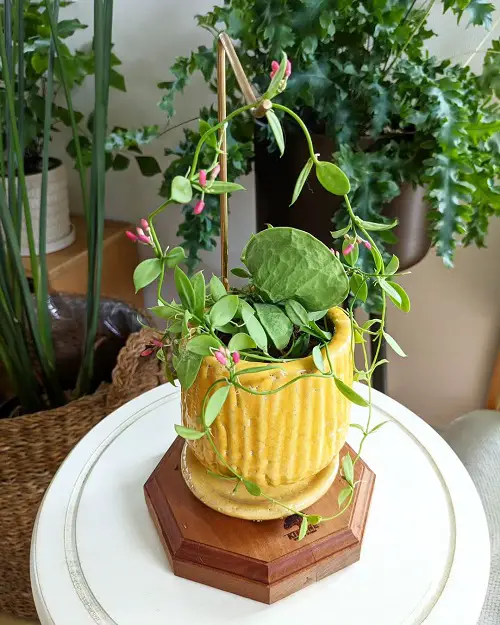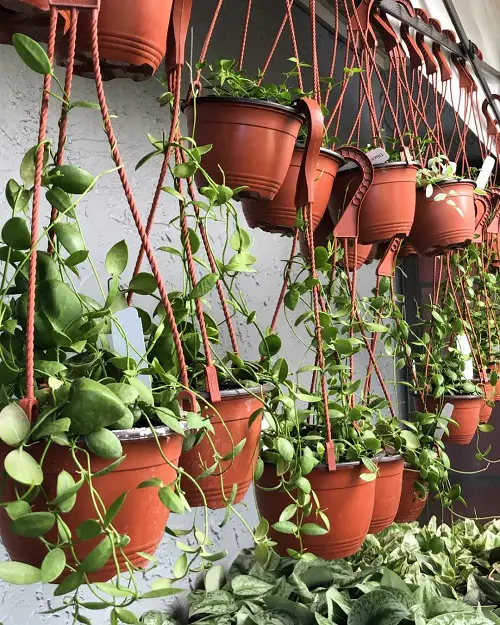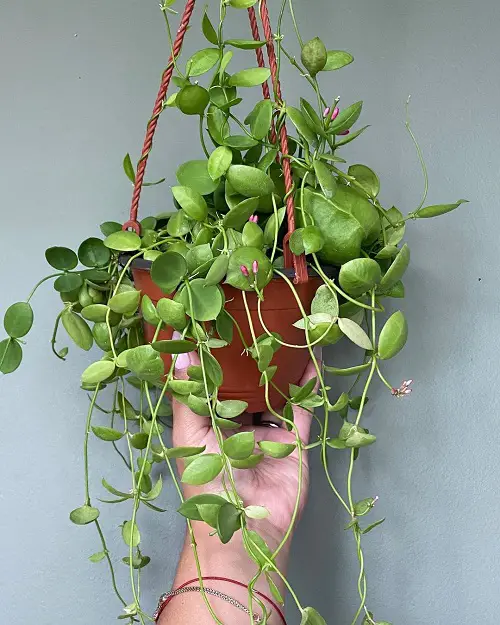Closely related to Hoya, Dischidia Pectinoides is a semi-succulent that will be more than happy to be trained indoors with minimal care!

Dischidia pectinoides is an absolute beauty and can thrive in any room indoors as long as you take proper care of it. Don’t worry, we’ll teach you how.
Dischidia Pectinoides Plant Information
Dischidia pectinoides is a rare epiphytic plant that comes from Asia, particularly the Southeast part of the continent.
It has small pouch-like leaves that are hollow inside and filled with roots. In the wild, these hollows are often home to ants, and their waste products act as natural fertilizer for the plant. Amazing, right? This is the same reason it’s also called the Ant Plant Dischidia pectinoides.
The leaves are vibrant green with darker stripes or marbling. This Dischidia also has flowers in a lovely red or pink color. They make great conversation starters.
Propagating Dischidia Pectinoides

The easiest and fastest method for propagating Dischidia Pectinoides is through stem cuttings.
Use a clean, sharp pair of scissors to cut a healthy stem section that has at least one leaf, ideally 4-6 inches long. Let the cutting air-dry for a few hours to allow the cut end to callous over.
Insert this calloused end into a pot filled with well-draining soil or place it in a jar of water. If you’re using soil, water it lightly; but if you’re using water, make sure to change it every few days. The roots should start to appear within 2-4 weeks. You can also take the help of this secret trick.
If you don’t want to go through the hassles of growing a plant from a cutting, which can be time-consuming, it would be a good idea to get a well-grown plant from a garden center!
Requirements to Grow Dischidia Pectinoides

Sunlight
Dischidia pectinoides need bright, indirect light to thrive. The best indoor location would be placing it near an east-facing window from where it gets light for 4-5 hours a day. Keep it away from direct sun as it can scorch the delicate leaves of the plant.
Pro Tip: If the leaves start to turn yellow, it may be an indication that the plant is receiving too much direct sunlight, and you will need to move it to a shadier spot.
Soil
When it comes to soil, Dischidia Pectinoides prefers moist, well-draining soil that is rich in organic matter. For the best growth, you can make a pocket-friendly medium at home by mixing.
- 1 part Garden soil (opt for a chunky and well-aerated mix)
- 1 part Coir or Peat Moss
- 1 Perlite or Sand
- 1/2 part Organic Compost
If you want a pre-mixed option you can find at most garden stores that are perfect for Dischidia pesticides, pick one that’s formulated for orchids or bromeliads.
Watering
Go easy on the plant when it comes to moistening the growing medium, as overwatering can lead to root rot. Also, let the soil dry out slightly between watering, but not completely.
Sticking your finger into the soil up to the second knuckle is the best way to check if the plant needs watering. If it’s dry, water it.
Temperature
Dischidia Pectinoides thrives in warm, humid environments and prefers temperatures between 60-90°F (15-32°C). Don’t keep it near AC or heating vents.
Dischidia Pectinoides Care

Fertilizer
This plant grows at its own sweet pace, so don’t worry about feeding it much. If you want to increase the size of the foliage and make it spread a little faster, then feed Dischidia pectinoides with a balanced liquid fertilizer once in 4-6 weeks after diluting it 1/2 to its strength.
Do remember, it doesn’t need fertilizer at all in winter.
Pests and Diseases
Dischidia Pectinoides is a relatively pest—and disease-resistant plant, but it is still important to look for signs of problems. Common pests that affect Dischidia Pectinoides are spider mites, mealybugs, and scale insects. You can treat these with insecticidal soap or neem oil.
Other than that, don’t overwater it because it will lead to fungal diseases. Also, don’t water the leaves—pour the water on the soil.


